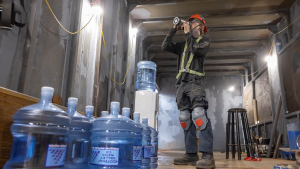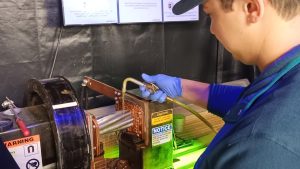Sometimes a demolition project is one of the most significant steps in renewal. Just days after EllisDon put the finishing touches on the $474-million forensic hospital at the Waypoint Centre for Mental Health Care in Penetanguishene, crews from JMX Contracting Inc. of Gormley, Ont. began tearing down old hospital rooms and cells that formed part of the original facility.
The site was first developed by John Graves Simcoe as a naval and military base following the War of 1812. The Boys Reformatory of Upper Canada was established there in 1859 and the existing buildings were converted to a mental health care facility in 1904.
"The original blueprints that we were supplied to work from on the demolition identify the site as a ‘hospital for the criminally insane,’" says Jeff Norton, JMX co-owner.
"Obviously, a lot of attitudes have changed since those plans were drawn up decades ago."
The project was built on a design-build-finance-maintain model under Integrated Team Solutions, a partnership with EllisDon as designer/builder, Fengate Capital, Honeywell Ltd., and National Bank Financial. JMX was sub-contracted by EllisDon to demolish two hospital facilities totaling 500,000 square feet.
The 160-bed Oak Ridge facility dates back to 1933 when four wards were originally constructed. Another four wards were built in the 1950s. Most recently, the high-security building housed the Provincial Forensic Program for offenders with mental disorders. The 20-bed Brébeuf building opened in 1967, offering a less institutionalized regional forensic program for those who have come into conflict with the law as a result of a serious mental illness.
Both programs have been relocated into the new 350,000-square-foot, 312-bed hospital facility, which is aiming for LEED Gold certification.
"We had quite a tight deadline on this one," says Norton.
"The residents were moved to the new facility on a Friday and we moved in with the equipment on the following Monday. We started work at the beginning of June and had to be out of there by the last day of September."
The low-rise buildings crested at four storeys, not including a chimney.
"You could see the history of the Oak Ridge building revealed as we tore down the cells," say Norton. "There were messages and graffiti from former residents etched into the concrete walls. Some of the guys said it was a really strange feeling dismantling a facility that contained all of the individual stories of the people who were treated there."
A fleet of CAT 345s equipped with grapples took the buildings apart from the top down, with shear attachments easily cutting through the iron bars of the cells.
"We recycled 96 per cent of the materials from the demolition," says Norton. "There was a lot of metal, from aluminum and copper to a full set of stainless steel sinks and toilets. We also recycled a fully equipped carpentry shop and exercise room."
All of the concrete was collected and crushed on site, then backfilled into the excavation footprints of each building. JMX also graded the site for later landscaping.
"Sometimes you know when a demolition job is part of something that will really improve people’s lives," says Norton.
"This move and renewal will be part of a considerable improvement in the lifestyle of the people who are being treated here."











Recent Comments
comments for this post are closed